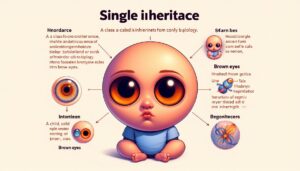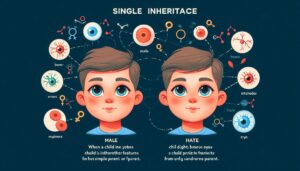Inheritance is a concept where traits or properties are passed down from one generation to another. This idea is very important in both biology and computer science.
In biology, inheritance explains how we get traits from our parents. In computer science, inheritance is about how classes share features. In this article, we will explore the different types of inheritance to understand how they work.
Read more:Best 50 Instagram Bio for Girls
Table of Contents
ToggleSingle Inheritance
Single inheritance is when a class (in computer science) or a child (in biology) inherits features from only one parent or class. This is the simplest form of inheritance. For example, a child might inherit brown eyes from one parent.

Multiple Inheritance
Multiple inheritance occurs when a class or child inherits features from more than one parent. This means combining traits from two or more sources.
For example, a child might inherit brown eyes from one parent and curly hair from the other. In computer science, this can be complex because it involves combining features from multiple classes.
Multilevel Inheritance
Multilevel inheritance happens when a class or child inherits features from a parent, and then another class or child inherits from that child. This creates a chain of inheritance.
For example, a grandchild might inherit traits from their parent, who inherited them from the grandparent.

Hierarchical Inheritance
Hierarchical inheritance is when multiple children inherit features from a single parent. This means one parent has many children who all inherit the same traits.
For example, if a parent has brown eyes, all their children might have brown eyes too.
Hybrid Inheritance
Hybrid inheritance is a mix of different types of inheritance. It can involve combining single, multiple, and multilevel inheritance. This creates a complex web of inherited traits.
For example, a child might inherit some traits from one parent and other traits from another parent, while also passing on new traits to their own children.

Importance of Inheritance
Inheritance is very important because it explains how traits are passed down through generations. In biology, it helps us understand genetics and how certain traits are inherited.
In computer science, it allows for the reuse of code, making programming more efficient.

Benefits of Understanding Inheritance
Predict Traits: Helps in predicting traits in future generations.
Efficient Programming: Makes programming easier and more efficient.
Better Planning: Assists in better planning for breeding in animals and plants.
FAQs
What is inheritance in biology?
Inheritance in biology is the process of passing traits from parents to their children. This includes things like eye color, hair color, and other physical features.
How does inheritance work in computer science?
In computer science, inheritance is when a new class uses features from an existing class. This helps in reusing code and building complex systems.
What is single inheritance?
Single inheritance is when a child or class inherits traits or features from only one parent or class.
Can a class inherit from multiple classes?
Yes, this is called multiple inheritance. It means a class gets features from more than one class.
Why is inheritance important?
Inheritance is important because it helps in understanding how traits are passed down in biology and how features can be reused in computer science.
Conclusion
Understanding the different types of inheritance is crucial for both biology and computer science. It helps explain how traits and features are passed down from one generation to the next.
Whether it’s predicting eye color or creating efficient code, inheritance plays a key role. By learning about single, multiple, multilevel, hierarchical, and hybrid inheritance, we can better understand the world around us.









